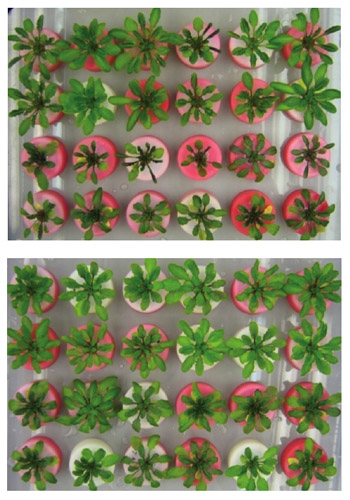Building a Better Salt Trap
By Catherine Clabby
With cell-specific bioengineering, scientists may have found a way to make plants more salt tolerant
With cell-specific bioengineering, scientists may have found a way to make plants more salt tolerant

DOI: 10.1511/2009.80.381
A strategy to protect crops from salty soils hit plant scientist Mark Tester in a flash ten years ago, while he was delivering a classroom lecture.
“I thought, we need to work out how to control gene expression around the roots and suck the salt out before it gets to the shoot,” says the University of Adelaide biologist based at the Australian Centre for Plant Functional Genomics.
In July, Tester and collaborators in Australia and England delivered on the vision. In the journal The Plant Cell, they showed how they amplified a laboratory plant’s natural ability to draw salt out of its xylem, diverting some of it from the plant’s water pipes in stems and, ultimately, in leaves, where salt buildup can become toxic.

Photos courtesy of the Australian Centre for Plant Functional Genomics, University of Adelaide.
The better-salt-trap trait is heritable in the Arabidopsis thaliana laboratory plants that Tester’s team bioengineered. He predicts they will repeat the feat in crop plants. Experiments with rice in his laboratory already show promising results, Tester says.
Soil salinity is one of a growing number of challenges facing agriculture around the world. As the human population continues to swell, so does demand for fertile ground to grow food. As the drive to plant more biofuel feedstock expands, competition for good farmland is expected to increase further.
Lurking in the background are the uncertain impacts of human-induced climate change, which may alter rain patterns, increase temperatures, raise sea levels and otherwise disrupt agriculture. Farmers large and small could be looking for means to plant on less-than-ideal farmland, including land with higher-than-desired salt levels, to cope with it all.
High soil salinity is believed to hinder crop yields in 100 countries. Hardest hit are farms and gardens in arid areas such as Pakistan, India, Egypt, Tunisia, Morocco, Peru and Bolivia, according to a 2008 Science report by Jelte Rozema of Vrije Universiteit in the Netherlands and plant physiologist Timothy Flowers of the University of Sussex in England.
But the contamination exists in more economically developed places too, including the United States and Australia. In an odd twist, irrigation is the most common human-induced cause of increased soil salinity. Applying water can double a field’s crop yield, but it can also deposit salt. Even more frequently, higher levels of evaporation and transpiration on irrigated fields draw salts closer to the surface. Once there, they are very hard to remove.
High salt concentrations can hurt plants in two ways. The osmotic effect hinders plants’ ability to draw water from soil. Second, when salt accumulates in plant tissue, it can cause premature leaf death.
So far, bioengineering has not delivered solutions. Rozema and Flowers in 2008 noted that between 1996 and 2006, 30 scientific reports emerged detailing approaches to genetically altered rice, a cereal highly intolerant of salt, to make it more salt tolerant. But such rice remains a work in progress.
Tester’s team focused only on certain cells in roots to rev up systems that already provide varying amounts of salt tolerance, depending on the plant species. Some plants have the ability to reduce the amount of salt that can reach their transpiration stream by diverting some into their roots before it travels up their shoots. “It’s a last-ditch defense,” Tester said.
Building on research by others, the investigators targeted the Arabidopsis HKT1;1 gene in cells near water-transport systems in mature roots. They inserted a second copy of the gene sequence itself, as well as a promoter designed to maintain high expression of the inserted gene. Laboratory plants modified in this way had 37 to 64 percent less salt in their shoots compared with unaltered plants after exposure to high salinity.
Questions remain about the capacity of this approach. Flowers, one of the coauthors of the 2008 Science article on the toll of salinated soil on crops, wonders just how much salt plants will be able to store in their roots.
“The limited capacity of the root parenchyma is likely to limit the quantity of sodium and chloride that can be removed from the transpiration stream,” says Flowers.
Tester says the approach could make a difference in the field. “We have not yet tested the limits of the technology, but we do know it works at fairly high levels of salinites.”
If it does work adequately, Tester hopes his focus on a gene already present in plants, rather than one imported from a very different organism, will make his strategy less disagreeable to people opposed to genetic transplantation because of concerns about potential environmental risks.
Julian Schroeder, Novartis professor in plant sciences at the University of California, San Diego, says that may be possible.
“Research in wheat suggests that naturally occurring variation in HKT transporter expression can enhance salt tolerance. The difference between molecular breeding and transgenic plants becomes small in this case,” Schroeder says.
Click "American Scientist" to access home page
American Scientist Comments and Discussion
To discuss our articles or comment on them, please share them and tag American Scientist on social media platforms. Here are links to our profiles on Twitter, Facebook, and LinkedIn.
If we re-share your post, we will moderate comments/discussion following our comments policy.